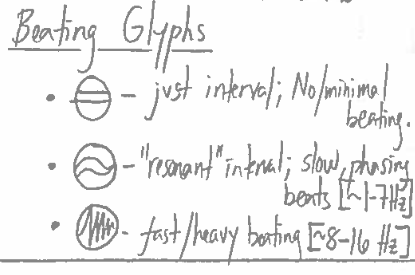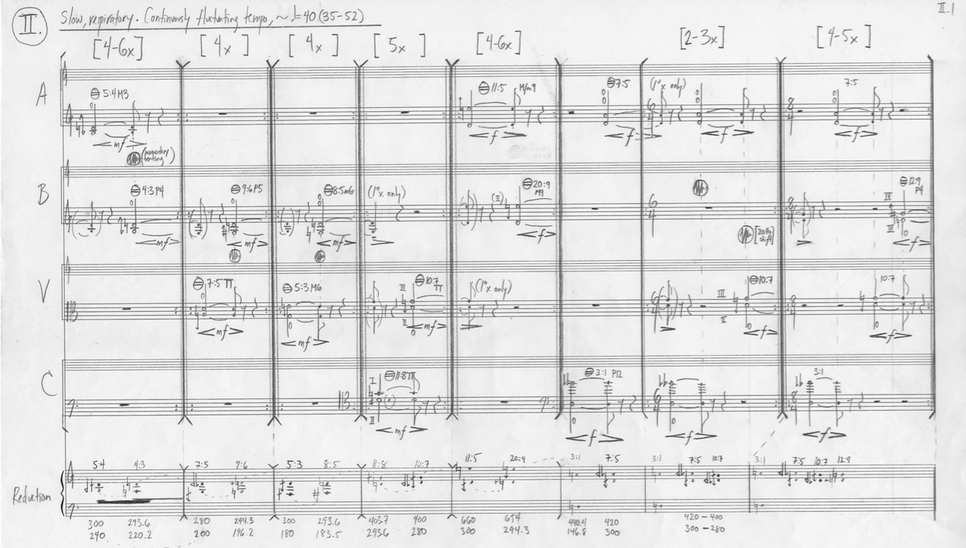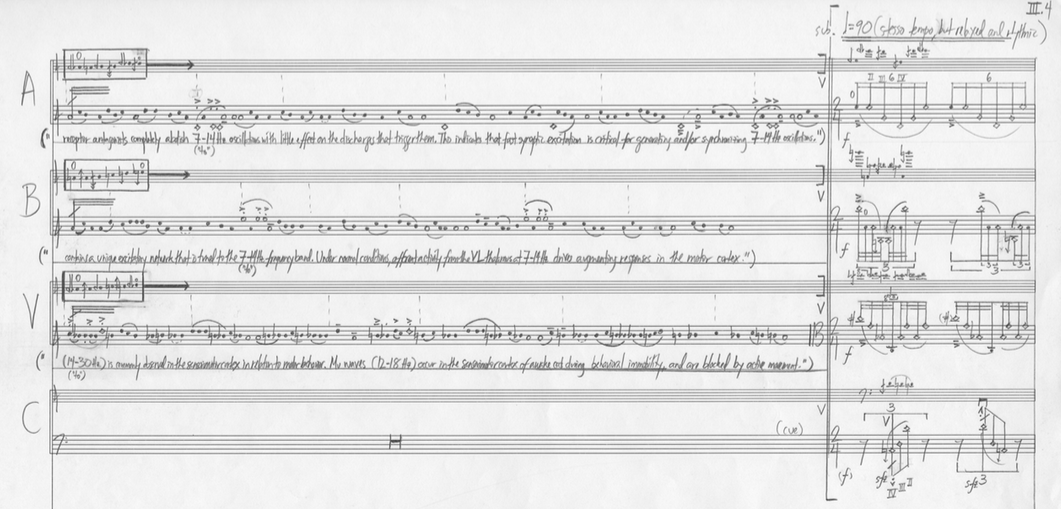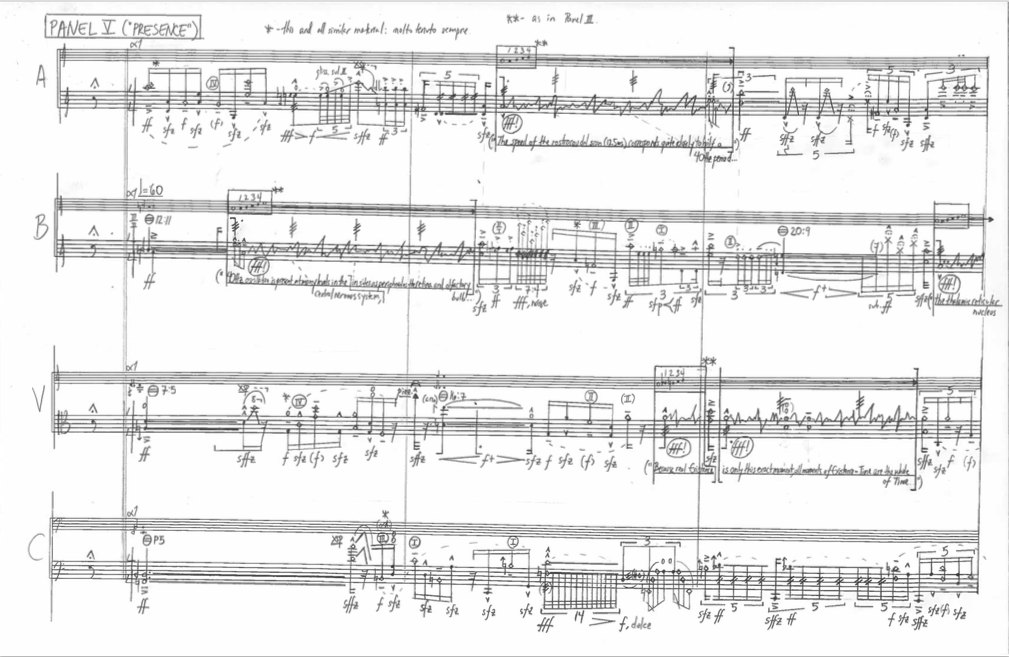being-time
[2013-17]
commissioned by Chamber Music America, for the Mivos Quartet (Josh Modney, Olivia de Prato, Victor Lowrie, Mariel Roberts)
first performance of the complete version: November 2, 2015, Roulette, Brooklyn, NY
instrumentation:
string quartet and electronic sound
duration: 55'-65'
About the Piece
"Music is time made audible." - Klaus Lang
"The view of time in Buddhism is always very realistic. Specifically, time is always related with existence and existence is always related with momentary time. So in reality, the past and the future are not existent time; the present moment is the only existent time – the point at which existence and time come together. And also, time is always related with action here and now. Action can only be realized in time, yet it is also true that time can only be realized through action." - Gudo Nishijima
“And then time is no longer an
obstacle, but the means by which the possible is
realized.” - Eliane
Radigue
Form
SEED
(Q=0)
*
Schisma
PANEL I ("Pure Duration")
Schisma
PANEL II ("Harmony")
Schisma
PANEL III ("Tempo")
PANEL IV ("Beating")
*
PANEL V ("Presence")
Tuning
At its simplest, this piece is the
exposition of a tuning. The quartet retunes to an
elaborate scordatura derived from four very low
fundamentals,
and the harmonic field generated from the
intersection of these four fundamentals, their 16
open-string "partials," and the harmonic series
ascending from each of these 16 strings ("partials
of partials") serves as the sonic fabric, the
"skin" of the piece.
Due to
the choice of fundamentals [32.7Hz C, 36.7Hz D,
40Hz E quarter-flat, 60Hz B quarter-flat] several
interesting things follow:
Beatings
The pitch space derived from this
tuning contains an abundance of intervals
separated by less than 20Hz. Further, due to the
scordatura these are idiomatically achievable (as
combinations of open strings and harmonics, e.g.)
and acoustically stable. In other words, I can
write an interval for two of the players in this
tuning that sustains a continuous and reliable
14Hz beating (as the interval between two open
strings).
This allows for the deployment of
precise beating speeds as musical structures (used
as rhythms or to set tempi), and also for a more fluid conception of consonance
and dissonance – as a spectrum of speeds and
intensities of acoustic beating.


While "schisma" does have a precise technical sense in tuning theory, I use it here in a more metaphorical way, as a kind of tectonic fissure between tuning grids.
In the "Schisma" sections that precede each of the first three panels, the players pass dyads back and forth. Each dyad is just-tuned and in-and-of-itself extemely consonant, but the interval between the two dyads is extremely narrow, generating dissonant friction and fast beating when they overlap and "touch." [For example, the open D-strings of the Viola and two Violins are tuned to 280Hz, 294.3Hz, and 300Hz, respectively, offering available intervals/beatings of 6.7Hz (moderate and wobbly), 14.3Hz (fast and harsh), and 20Hz (buzzing, almost itself a difference tone).]
"formants"
The use of 40 and 60Hz
as fundamentals offers access to several
acoustic and perceptual "formants" (unarbitrary
frequencies of special resonance in a
space).
The cellist tunes the C-string down
to B quarter-flat, sounding 60Hz. Playing a 60Hz
pitch in any room with electrical lighting or
idling appliances can produce an acoustic
reinforcement akin to the "singing in the shower"
effect, as 60Hz is the frequency at which voltage
travels in the continental U.S.
It's also a pitch, though– the fundamental pitch
of your refrigerator or flourescent lightbulbs or
the power lines outside or LaMonte Young's
music...
40Hz even
more so aligns with the grain of the human
auditory and perceptual system. It's an octave
multiple of 20Hz, the threshold frequency which
both divides the perception of pitch from that of
rhythm, and, non-coincidentally, sets a hard limit
for the speed of motor/muscular functions in the
human body. It has also been proposed as a
resonant frequency of certain brain structures,
and the rate at which some electrical signals
travel in the brain, particularly ones associated
with "temporal binding." To put it bluntly, it's
possible that 40Hz is the speed at which time
moves in the brain
(see the nerdy "Bibliography" below), and that
half of a 40Hz period is the smallest grain-size
of neural time, a "quantum of
consciousness."

Another conceit of the piece is that
the self-similarity of the material allows for it
to be either extended in time (i.e. the movements
follow each other sequentially, as a traditional
concert piece) or remain more or less un-extended,
in which case all of the material can be presented
simultaneously as a "time-object."
The form again:
SEED
(Q=0)
*
Schisma
PANEL I ("Pure Duration")
Schisma
PANEL II ("Harmony")
Schisma
PANEL III ("Tempo")
PANEL IV ("Beating")
*
PANEL V ("Presence")
Within this form, three versions of the piece
co-exist (separated by the asterisks). The
sequential, linear, concert version of the piece
begins with the first Schisma and proceeds through
the end of Panel IV. At this point, the piece is
functionally complete, and in the concert version
must be shocked back to life by a "Schreckensfanfare," a series of noise bursts that
compress all of the previous 50 minutes of music
into 400 milliseconds. This Beethovinian reboot
supplants the sequential presentation of the first
four panels with the simultaneous "time-object" of
Panel V.
Panel V, one its own, is thus a
competing and self-standing version of the piece.
In Panel V, the material from the first four
panels is collaged into two versions of a 45"
ritornello/buffer, repeated in alternation against
a gradually enveloping electronic drone composed
of layers of time-stretched recordings of Panels
I-IV, live processing of the quartet with an
"infinite reverb" patch, and live improvisation by
the electronics performers with up to 16 channels
of granulated recordings of the piece.
In the album version, the first
Schisma is preceded by a 1-minute hyper-compressed
"pill" version of the piece, a seed in which it is
possible to hear the entirety of the material that
will unfold over the course of the subsequent
hour. This, again, represents a functional and
self-contained "version" of the piece that
challenges the full concert-version for primacy
(... kind of, anyway).
A final, yet-to-be-presented version
of the piece exists as a multi-channel
installation, diffusing the granulated recordings
from Panel V throughout a concert/gallery space
over an indefinite duration in a continuous,
non-repeating fabric. (And again again, I consider
this version more-or-less "equal" in some
meaningful sense to the concert version of the
piece.)

Bibliography
The
theoretical underpinning for this piece was informed
by a long period of research. While my pursuit of
this "research" was more poetic, intuitive, and
cherry-pick-y than rigorously scientific (and e.g.
often done with bottle or joint in hand...), I
imagine that many of the articles/ideas/ways of
thinking that I came across in the course of it
could be interesting for similarly minded musicians.
So, to
that end:
Amacher, M. “Psychoacoustic Phenomena in
Musical Composition: Some Features of a ‘Perceptual
Geography’,” in Arcana III, New York, NY:
Hips Road, 2008.
Castanet, P.A. (2000). Gérard Grisey and the Foliation of Time. Contemporary Music Review, Vol. 19, Part 3, p.29-40.
Castro-Alamancos, M. (2013). The motor cortex: a network tuned to 7-14 Hz. Frontiers in Neural Circuits, 7(21).
Clarke, E. (1987). Levels of structure in the organization of musical time. Contemporary Music Review, Vol. 2, p.211-238.
Edmonds, E.D.M. et al. (1981) The estimation of time as a function of positive, neutral or negative expectancies. Bull. Psychonomic Soc. 17, 41 259–260
Eihei Dogen (trans. Rev. Hubert Nearman, O.B.C.). Shobogenzo. Shasta Abbey Press, Mount Shasta, CA.
Droit-Volet, S. and Meck, W. (2007). How emotions colour our perception of time. TRENDS in Cognitive Sciences, Vol. 11 No. 12.
Farb N., Segal Z., Mayberg H., Bean J., McKeon D., Fatima Z., Anderson A. (2007). Attending to the present: mindfulness meditation reveals distinct neural modes of self-reference. SCAN 2, 313-322.
Grisey, G. (1987). Tempus ex Machina: A composer's reflections of musical time. Contemporary Music Review, Vol. 2, p. 239-275.
Harrison,
Bryn (2007). Cyclical Structures and the
Organisation of Time. University of
Huddersfield.
Katagiri,
D. Each Moment is the Universe. Boston:
Shambala, 2008.
D. T. Kemp, “Stimulated acoustic emissions from within the human auditory system,” J. Acoust. Soc. Am., vol. 64, no. 5, pp. 1386–1391, Nov. 1978.
G. Kendall, C. Haworth, and R. F. Cadiz, “Sound Synthesis with Auditory Distortion Products,” Computer Music Journal, vol. 38, no. 4, Winter 2014.
Kirk, J. (2010). Otoacoustic Emissions as a Compositional Tool. ICMC 2010, p.316-318.
Llinás R. and Ribary U. (1993). Coherent 40-Hz oscillation characterizes dream state in humans. Proc. Natl. Acad. Sci. USA, Vol. 90, pp. 2078-2081.
Llinás R. and Ribary U. (1994). Human oscillatory brain activity near 40 Hz coexists with cognitive temporal binding. Proc. Natl. Acad. Sci. USA, Vol. 91, pp. 11748-11751.
McAdams, S. (1989). Psychological constraints on form-bearing dimensions in music. Contemporary Music Review, Vol. 4, p. 181-198.
Oster G.
(1973). Auditory Beats in the Brain. Scientific
American, 1973, 229(4), 94-103.
Salt, A. and Kaltenbach, J. (2011). Infrasound from Wind Turbines Could Affect Humans. Bulletin of Science, Technology, and Society, 31(4) p.296-302.
Stockhausen, K. (1955). Structure and Experiential Time. Die Reihe, Vol. 2, p. 64-74.
Wittmann M., van Wassenhove V., Craig A.D., Paulus M. (2010). The neural substrates of subjective time dilation. Frontiers in Human Neuroscience, Vol. 4.
Wittmann
M. (2009). The inner experience of time. Phil.
Trans. R. Soc. B, 364, 1955-1967.
... and
music by Peter Ablinger (in particular Weiss/Weisslich
22: Haydn, Mozart, Beethoven, Schubert, Bruckner,
Mahler), Maryanne
Amacher, Anthony Braxton,
Aldo Clementi (Madrigale), James Fei (Horizontal
/ Vertical), Morton Feldman, Gérard Grisey,
Bryn Harrison (Surface Forms Repeating),
Klaus Lang, Alvin Lucier, Giorgio Netti, Chris Otto
(Violin Octet), Eliane Radigue, Wolfgang von
Schweinitz, Karlheinz Stockhausen, and LaMonte
Young.
... and
film/TV by David Lynch and Eric Andre (esp. The
Eric Andre Show Season Two Finale, which was
the key that opened up a way to realize Panel V...).